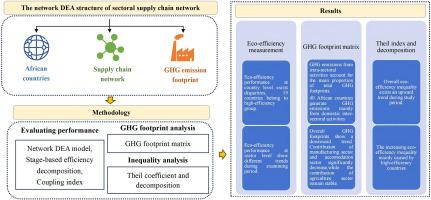揭示非洲部门生态效率差异:温室气体排放和政策路径的综合投入产出网络DEA方法
IF 11.2
1区 社会学
Q1 ENVIRONMENTAL STUDIES
引用次数: 0
摘要
非洲多样化的经济格局对协调经济增长与环境保护提出了挑战。为了提高非洲国家与可持续发展目标(sdg)的一致性,重要的是制定一个评估非洲国家生态效率绩效的框架。本研究提出了一个结合网络数据包络分析(用于生态效率分析)、多区域投入产出表(用于部门供应链分析)、温室气体足迹矩阵(用于环境影响评估)和Theil指数(用于生态效率不平等分析)的新框架。据我们所知,这项研究的框架在现有的研究中找不到。在实证方面,本研究将该框架应用于2015年至2019年的54个非洲国家。生态效率评价结果显示国家层面的效率绩效存在差异,部门层面的效率趋势存在差异。在温室气体足迹结果方面,农业部门的温室气体足迹呈稳定趋势,而住宿和制造业的温室气体排放贡献呈显著下降趋势。非洲国家的总体温室气体足迹呈下降趋势,但不同的模式仍然存在。Theil指数分解结果表明,部门间的生态效率不平等日益加剧,其中高生态效率经济体的群体内差异是造成不平等的主要原因。关键的政策影响包括改善对可持续技术的投资,加强限制温室气体排放的法规,以及促进公私伙伴关系。研究结果主张进一步研究长期战略影响、更广泛的地理研究和比较全球分析,以支持非洲的可持续发展和环境恢复能力。本文章由计算机程序翻译,如有差异,请以英文原文为准。

Unveiling sectoral eco-efficiency disparities in Africa: An integrated input-output network DEA approach to GHG emissions and policy pathways
Africa's heterogeneous economic landscape poses challenges in reconciling economic growth with environmental protection. To improve African countries' alignment with Sustainable Development Goals (SDGs), it is important to develop a framework for the evaluation of eco-efficiency performance in African countries. This study proposes a new framework combining network Data Envelopment Analysis (for eco-efficiency analysis), Multi-Regional Input-Output table (for sectoral supply chain analysis), GHG footprint matrix (for environmental impact assessment) and Theil index (for eco-efficiency inequality analysis). The framework of this study, to the best of our knowledge, cannot be found in existing studies. Empirically, this study applies the framework to 54 African countries from 2015 to 2019. Results of eco-efficiency evaluation show differences in country-level efficiency performance and divergence in sector-level efficiency trends. As for the GHG footprint results, the agriculture sector shows a stable trend of GHG footprints, while the contribution of GHG emissions from accommodation and manufacturing sectors present a significant downward trend. Overall GHG footprints show a downward trend across African countries, while divergent patterns persist. Results of Theil index decomposition reveal increasing eco-efficiency inequality within sectors, with most of the inequality resulting from intra-group differences in high-eco-efficiency economies. Key policy implications include improving investment in sustainable technologies, enhancing regulations to restrict GHG emissions, and fostering public-private partnerships. The findings advocate for further research on long-term strategy impacts, broader geographical studies, and comparative global analyses to support sustainable development and environmental resilience in Africa.
求助全文
通过发布文献求助,成功后即可免费获取论文全文。
去求助
来源期刊

Environmental Impact Assessment Review
ENVIRONMENTAL STUDIES-
CiteScore
12.60
自引率
10.10%
发文量
200
审稿时长
33 days
期刊介绍:
Environmental Impact Assessment Review is an interdisciplinary journal that serves a global audience of practitioners, policymakers, and academics involved in assessing the environmental impact of policies, projects, processes, and products. The journal focuses on innovative theory and practice in environmental impact assessment (EIA). Papers are expected to present innovative ideas, be topical, and coherent. The journal emphasizes concepts, methods, techniques, approaches, and systems related to EIA theory and practice.
 求助内容:
求助内容: 应助结果提醒方式:
应助结果提醒方式:


